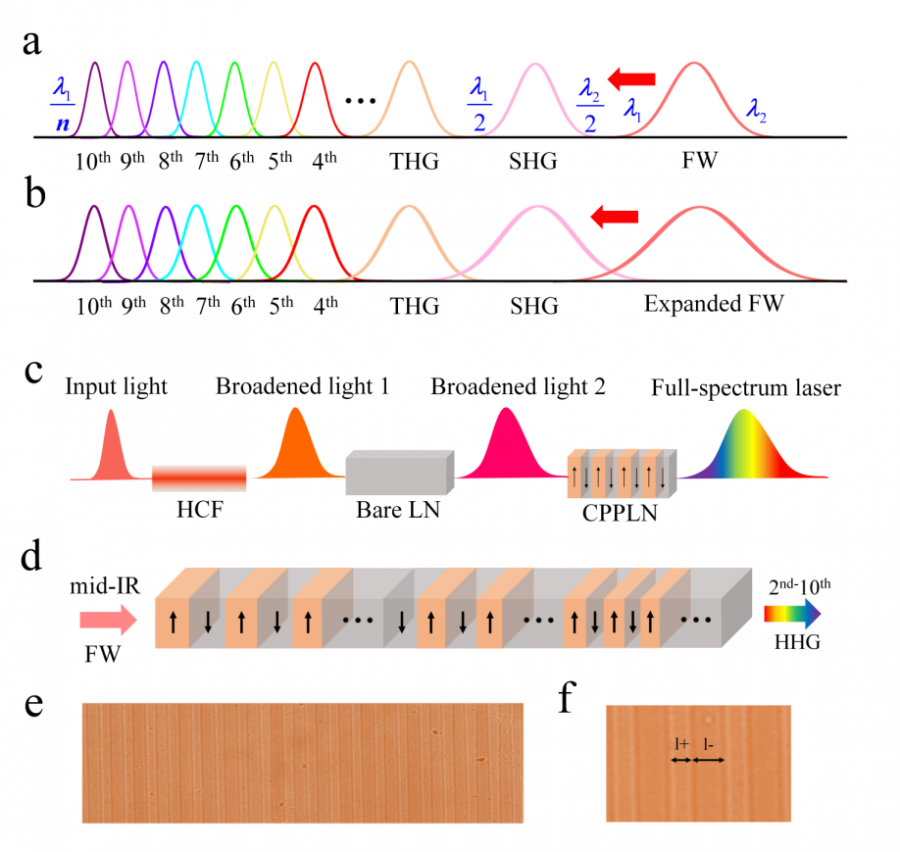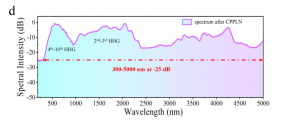
Intense ultraviolet-visible-infrared full-spectrum laser
FAYETTEVILLE, GA, USA, September 1, 2023/EINPresswire.com/ -- High-brightness femtosecond laser sources with large spectral coverage are indispensable tools that enable optical spectroscopy to simultaneously resolve the ultrafast dynamics of multiple physical, chemical, and biological processes of a sample. Hong et al. constructed an unprecedented bright, smooth, and flat 300-5000 nm ultraviolet-visible-infrared full-spectrum femtosecond white-light laser source by exploiting the efficient second- and third-order nonlinear interactions in a cascaded architecture of gas-filled hollow-core fiber, a bare lithium niobate crystal plate, and a specially designed chirped periodically poled lithium niobate crystal, which is pumped by an intense mid-infrared femtosecond laser.
A high-brightness ultrabroadband supercontinuum white laser has attracted more and more attention in physics, chemistry, biology, materials science, and other disciplines of science and technology. Over the past decades, many different approaches have been developed for supercontinuum white laser generation. Most of them utilize various third-order nonlinear effects (3rd-NL) like self-phase modulation (SPM) occurring within microstructured photonic crystal fibers or homogeneous plates, or noble gas-filled hollow-core fibers. However, the quality of these supercontinuum sources has been subject to some limitations, such as small pulse energy at nanojoule level and request of complicated dispersion engineering. Another more powerful means to expand the spectral range of laser is various second-order nonlinear effects (2nd-NL) via the promising route of quasi-phase matching (QPM) scheme. However, these purely 2nd-NL schemes are still poor in the performance of spectral and power scaling because of narrow pump bandwidth, limited QPM working bandwidth, and degraded energy conversion efficiency in higher-order harmonics. Frankly speaking, it has become a great challenge to resolve these bad limitations existing in both 2nd-NL and 3rd-NL regimes and make the best of both worlds for producing a full-spectrum supercontinuum laser with spectral coverage from UV to mid-IR range.
In a new paper published in Light Science & Application, a team of scientists, led by Professor Zhi-Yuan Li from School of Physics and Optoelectronics, South China University of Technology, China and co-workers have demonstrate an intense four-octave-spanning ultraviolet-visible-infrared (UV-Vis-IR) full-spectrum laser source (300 nm to 5000 nm at -25 dB from the peak) with the energy of 0.54 mJ per pulse coming from a cascaded architecture of gas-filled hollow-core fiber (HCF), a bare lithium niobate (LN) crystal plate, and a specially designed chirped periodically poled lithium niobate crystal (CPPLN), which is pumped by a 3.9 mm, 3.3 mJ mid-IR pump pulse. Under the pump of a 3.3 mJ 3.9 μm mid-IR femtosecond pulse laser, the HCF-LN system can generate an intense one-octave bandwidth mid-IR laser pulse to serve as the secondary FW pump input into the CPPLN, while the CPPLN supports high-efficiency broadband HHG processes to further expand greatly the spectral bandwidth into UV-Vis-NIR. Obviously, this cascaded architecture creatively satisfies the two preconditions for generating full-spectrum white laser: Condition 1, an intense one-octave pump femtosecond laser, and Condition 2, a nonlinear crystal with extremely large frequency up-conversion bandwidth. Moreover, the system involves considerable synergic action of 2nd-NL and 3rd-NL effects.
Such a synergy mechanism they developed brings a superior power to build a superior expansion of the overall UV-Vis-IR supercontinuum spectrum and filling-in of the spectral gaps among various HHG far exceeding those achieved by single action of either 2nd-NL or 3rd-NL effects that were adopted in previous works. As a result, such a cascaded HCF-LN-CPPLN optical module has enabled access to a previously inaccessible level of an intense full-spectrum laser output, with not only an extremely large bandwidth (spanning 4 octaves), but also high-flatness spectral profile (from 300 to 5000 nm with a flatness better than 25 dB), and large pulse energy (0.54 mJ per pulse).
“We believe that our scheme to create an intense four-octave-spanning UV-Vis-IR full-spectrum femtosecond laser source by harnessing the synergic action of 2nd-NL HHG and 3rd-NL SPM effects represents a big step for the construction of supercontinuum white laser source with larger bandwidth, larger power energy, higher spectral brightness, and flatter spectral profile. Such an intense full-spectrum femtosecond laser would provide a revolutionary tool for optical spectroscopy and find potential applications in physics, chemistry, biology, materials science, information technology, industrial processing, and environment monitoring. ” the scientists stress.
###
References
DOI
10.1038/s41377-023-01256-6
Original Source URL
https://doi.org/10.1038/s41377-023-01256-6
Funding information
The authors are grateful for the financial support from the National Natural Science Foundation of China (11974119, 61925507, 62075227), Science and Technology Project of Guangdong (2020B010190001), Guangdong Innovative and Entrepreneurial Research Team Program (2016ZT06C594), National Key R&D Program of China (2018YFA 0306200), Shanghai Rising-Star Program (21QA1410200), and Youth Innovation Promotion Association CAS (2020248).
About Light: Science & Applications
The Light: Science & Applications will primarily publish new research results in cutting-edge and emerging topics in optics and photonics, as well as covering traditional topics in optical engineering. The journal will publish original articles and reviews that are of high quality, high interest and far-reaching consequence.
Wendy Chen
TranSpread
email us here
Distribution channels: Energy Industry, Science, Technology
Legal Disclaimer:
EIN Presswire provides this news content "as is" without warranty of any kind. We do not accept any responsibility or liability for the accuracy, content, images, videos, licenses, completeness, legality, or reliability of the information contained in this article. If you have any complaints or copyright issues related to this article, kindly contact the author above.
Submit your press release



